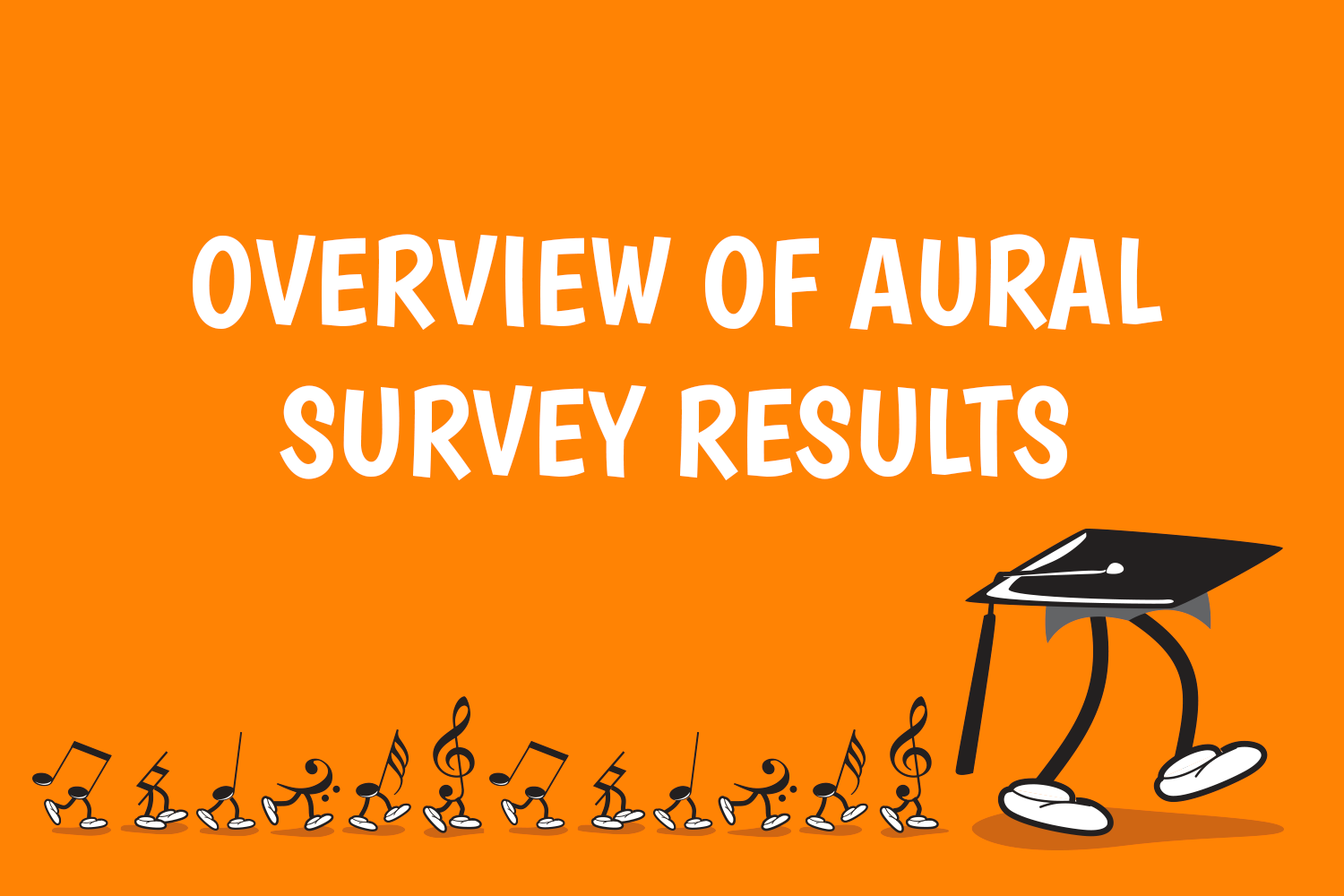Overview of Aural Survey Results

In the February BlitzBooks newsletter, I wrote an article summarising some of the survey results. This contained some fascinating data, including the fact that professional musicians had only slightly better aural skills than non-musicians.
Here, finally, is a much more detailed overview. Just to recap my reasons for setting up this survey in the first place: I have observed many times in the past an individual who is supposedly ‘tone deaf’ being able to accurately identify a certain pitch or piece of music, as long as it was very familiar to them. I thought it would be fun to devise a survey full of very familiar sounds to test the level of aural accuracy, and for this test to be open to absolutely anyone and everyone. While I was putting it together I have to say I was a little worried that perhaps it was too tricky for non-musicians, but I was HOPING that I was wrong… and I’m so glad I was!!!
I’ll start by showing the breakdown of correct answers for each of the 10 sounds in the survey (participants could choose to skip the question if they had never heard it before. This happened most for the Skype dial tone):

As you can see, the iPhone message alert had the most correct answers, and by far the fewest incorrect answers.
Next, here is a table showing how familiar each sound was. As you can see, Fur Elise was the most familiar, followed closely by Beethoven’s 5th .

The least familiar sounds were the Skype dial tone and the Windows Hardware sound (i.e. when you insert a USB to a Windows PC). Less than half of the respondents said that they had ‘heard this heaps’. This correlates to the high levels of incorrectness for those same sounds.
We can’t be certain exactly why the Skype or USB insertion sound was so unfamiliar, however we do know that of all the surveys completed, over half were done on an Apple computer, whilst only one third were completed on a Windows computer, which accounts for the lack of familiarity with the Windows sound.
The sound that was most correctly identified, by a long way, was the iPhone Message sound (even though this was the 4th most familiar). Beethoven’s 5th and Fur Elise, the two most recognisable sounds according to responses, came in 2nd and 3rd for correctness. This led me to think: why is it that the most familiar sound was not also the most correctly identified? Perhaps it is the fact that whilst a piece such as Fur Elise and a sound such as the iPhone message alert were both classified as ‘very familiar’, the iPhone sound is probably heard several times a day, whereas Fur Elise is very unlikely to be heard so frequently. It appears that a high frequency ofexposure to a sound most likely increases the accuracy with which it is remembered.
It was also very interesting to look at the breakdown of familiarity, across the four categories of participants: Professional musician, music student, occasional player and non-musician. Here are more charts showing the percentage of answers correct, based on familiarity with the sound, across the 4 categories:

Students

Occasional playing

None

The teacher/professional musician group, as expected, had the highest accuracy rate when sounds were very familiar. The scores for the less familiar sounds were a little erratic throughout all groups. It is important to note that orchestral pieces such as Beethoven’s 5th, and in fact any classical pieces, are often heard in arrangements in different keys, particularly in a piano teacher’s studio. The digital sounds however, such as the iPhone message alert, are always heard at the same pitch, which most likely accounts for the increase in accuracy.
Interestingly, even the ‘lowest’ results, coming from the non-musicians who were least familiar with the sounds, were still above chance. That is, given 3 options there is a 33% chance the right answer will be selected with a pure guess. The percentages shown above are well above this mark.
At the end of the survey, we asked participants to tell us of their contribution to music. Here is a chart showing the percentage of correct answers based on musical training:

As you can see, the music students fared the best in this regard. This is possibly due to their younger age and higher exposure to the digital sounds.
It is interesting to observe the erratic scores from the professional group. This comes back to familiarity: Over 23% of the professional group say they had never heard the Skype sound before, and over 20% said they had never heard the Windows sound. The typical demographic of music teachers who took the survey suggests that they are less involved with technology on a day to day basis.
In terms of self-rating of aural skills, it was fascinating to see that those with ‘virtually non-existent’ aural skills got almost just as high a score as those who said their skills were fair!

The most interesting chart of all, in my opinion, is the breakdown of self-rating of aural skills amongst the professional group:

Whilst one would expect to see the lowest scores in the ‘Virtually non-existent’ column, the scores in the ‘Only Fair’ column are by far the worst. This suggests that those who classify themselves as having ‘non-existent’ aural skills are either incapable of self-assessment, or, as is probably more likely, suffering from a lack of self-esteem about their aural ability. I have had many conversations with fellow musicians over the years on this topic; some assume they don’t have ‘any’ aural skills simply because they do not possess absolute pitch, or because they didn’t fare well in aural tests as a student. However, it is unlikely that a professional musician could thrive in the musical world without any aural skills. A self-rating of ‘only fair’ is probably far more accurate for those who are not confident, and is most likely as low as it goes when compared to the general public.
Having said this, the scores are only marginally higher for those who rated themselves as having ‘very good’ aural skills. This indicates that the ‘only fair’ group potentially underestimate their skills in this area, which supports the anecdotal observation of a general lack of self-esteem which it comes to aural ability.
Interestingly, the iPhone message was not the highest score, as it was for overall correct responses. Once again this most likely goes towards the demographic of this group, consisting of teachers aged 35 and above.
The survey also asked participants to say how confident they were with their answers. Levels of confidence had a very high match with correctness. Those who were guessing, however, still have results well above chance (33.3%) with the notable exceptions of the Skype dial tone (extremely unfamiliar overall) and the iPhone message sound (extremely familiar overall):

The final table I would like to show is that of percentage of correct answers based on experience with music i.e. how long a musical instrument has been played:

The colours speak for themselves – youth and good aural skills go together! The low score for Skype amongst the 25+ years group shows that this demographic obviously prefers other means of communication ☺.
It is fascinating to note that even the lowest score for those who have no involvement with music is still significantly above chance, demonstrating that non-musicians have just as much capability of developing good aural skills as musicians.
This survey has shown without a doubt that people have an innate aural ability that they are essentially unaware of. In musical terms, participants were asked to identify the correct pitch of a sound to within 3 semitones. They were successful most of the time, whether involved with music or not! This demonstrates that excellent pitch memory is possible as long as a sound is heard often enough, and if exposure to single notes could be regarded as a refinement of this skill, it makes sense that most people are quite capable of developing absolute pitch.
